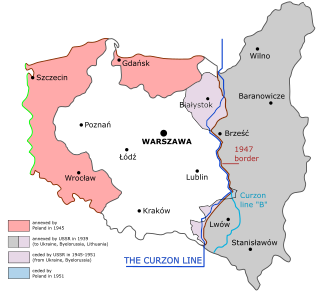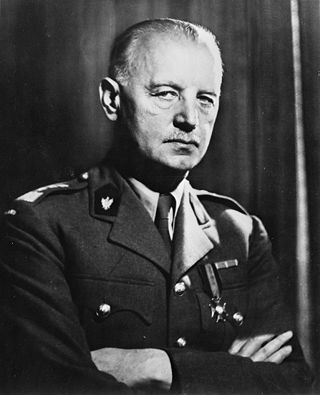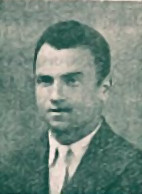This article needs additional citations for verification .(September 2011) |
Roman Umiastowski, who was born on January 29, 1893, in Warsaw and died on December 29, 1982, in London, has been a colonel in the Polish Army, a patriot and a bibliophile.
This article needs additional citations for verification .(September 2011) |
Roman Umiastowski, who was born on January 29, 1893, in Warsaw and died on December 29, 1982, in London, has been a colonel in the Polish Army, a patriot and a bibliophile.
When the Germans invaded Poland, Umiastowski was the head of the propaganda department in the Polish High Staff. On the night of 6/7 September 1939 he aired a message on the radio, urging all able men of Warsaw to go to the front; the idea was to man a defense line east of the Vistula. [1] The result is said to have been one of the most legendary traffic jams in history. [2] Umiastowki continued his work after arriving in England after the military collapse in 1939 and published ("with the assistance of Joanna Mary Aldridge"): Russia and the Polish Republic 1918 - 1941 (London, 1945?, pp 320 ) and Poland, Russia and Great Britain 1941 - 1945. A Study of Evidence(London, 1946, pp 544). The first in memory of his son, lieutenant Jan Kazimierz, who fell on May 11, 1944, as a member of The 5th Wilno Brigade at Monte Casino, Italy. Both books are documented by a wealth of source material. After the war Colonel Umiastowski pursued his hobby, bibliophily. He had a remarkable collection, among which an important copy of Copernicus's De revolutionibus, which he eventually donated to a Polish library. [2]
In the 1970s, he published two science fiction novels, under the pen name of Boleslaw Zarnowiecki.

The history of Poland spans over a thousand years, from medieval tribes, Christianization and monarchy; through Poland's Golden Age, expansionism and becoming one of the largest European powers; to its collapse and partitions, two world wars, communism, and the restoration of democracy.

Józef Klemens Piłsudski was a Polish statesman who served as the Chief of State (1918–1922) and First Marshal of Poland. In the aftermath of World War I, he became an increasingly dominant figure in Polish politics and exerted significant influence on shaping the country's foreign policy. Piłsudski is viewed as a father of the Second Polish Republic, which was re-established in 1918, 123 years after the final Partition of Poland in 1795, and was considered de facto leader (1926–35) of the Second Polish Republic as the Minister of Military Affairs.

The Invasion of Poland, also known as the September Campaign, Polish Campaign, War of Poland of 1939, and Polish Defensive War of 1939, was a joint attack on the Republic of Poland by Nazi Germany, the Slovak Republic, and the Soviet Union; which marked the beginning of World War II. The German invasion began on 1 September 1939, one week after the signing of the Molotov–Ribbentrop Pact between Germany and the Soviet Union, and one day after the Supreme Soviet of the Soviet Union had approved the pact. The Soviets invaded Poland on 17 September. The campaign ended on 6 October with Germany and the Soviet Union dividing and annexing the whole of Poland under the terms of the German–Soviet Frontier Treaty. The invasion is also known in Poland as the September campaign or 1939 defensive war and known in Germany as the Poland campaign.

The Curzon Line was a proposed demarcation line between the Second Polish Republic and the Soviet Union, two new states emerging after World War I. Based on a suggestion by Herbert James Paton, it was first proposed in 1919 by Lord Curzon, the British Foreign Secretary, to the Supreme War Council as a diplomatic basis for a future border agreement.

The history of Poland from 1939 to 1945 encompasses primarily the period from the invasion of Poland by Nazi Germany and the Soviet Union to the end of World War II. Following the German–Soviet non-aggression pact, Poland was invaded by Nazi Germany on 1 September 1939 and by the Soviet Union on 17 September. The campaigns ended in early October with Germany and the Soviet Union dividing and annexing the whole of Poland. After the Axis attack on the Soviet Union in the summer of 1941, the entirety of Poland was occupied by Germany, which proceeded to advance its racial and genocidal policies across Poland.

Władysław Eugeniusz Sikorski was a Polish military and political leader.

The Warsaw Uprising was a major World War II operation by the Polish underground resistance to liberate Warsaw from German occupation. It occurred in the summer of 1944, and it was led by the Polish resistance Home Army. The uprising was timed to coincide with the retreat of the German forces from Poland ahead of the Soviet advance. While approaching the eastern suburbs of the city, the Red Army halted combat operations, enabling the Germans to regroup and defeat the Polish resistance and to destroy the city in retaliation. The Uprising was fought for 63 days with little outside support. It was the single largest military effort taken by any European resistance movement during World War II.

Roman Garby-Czerniawski was a Polish Air Force captain and Allied double agent during World War II who used the code name Brutus.

The Polish government-in-exile, officially known as the Government of the Republic of Poland in exile, was the government in exile of Poland formed in the aftermath of the Invasion of Poland of September 1939, and the subsequent occupation of Poland by Germany, the Soviet Union, and the Slovak Republic, which brought to an end the Second Polish Republic.

Marshal Edward Rydz-Śmigły, also called Edward Śmigły-Rydz, was a Polish politician, statesman, Marshal of Poland and Commander-in-Chief of Poland's armed forces, as well as a painter and poet.

Lucjan Żeligowski was a Polish-Lithuanian general, politician, military commander and veteran of World War I, the Polish-Soviet War and World War II. He is mostly remembered for his role in Żeligowski's Mutiny and as head of a short-lived Republic of Central Lithuania.

Karol Wacław Świerczewski was a Polish and Soviet Red Army general and statesman. He was a Bolshevik Party member during the Russian Civil War and a Soviet officer in the wars fought abroad by the Soviet Union including the one against Polish as well as Ukrainian Republics and in Republican Spain. In 1939 he participated in the Soviet invasion of Poland again. At the end of World War II in Europe he was installed as one of leaders of the Soviet-sponsored Polish Provisional Government of National Unity. Soon later, Świerczewski died in a country-road ambush shot by the militants from OUN-UPA. He was an icon of communist propaganda for the following several decades.

Szymon Datner was a Polish historian, Holocaust survivor and underground operative from Białystok, best known for his studies of the Nazi war crimes and events of The Holocaust in the Białystok region. His 1946 Walka i zagłada białostockiego ghetta was one of the first studies of the Białystok Ghetto.

The Polish resistance movement in World War II, with the Polish Home Army at its forefront covered both German and Soviet zones of occupation. The Polish resistance is notable among others for disrupting German supply lines to the Eastern Front, and providing intelligence reports to the British intelligence agencies. It was a part of the Polish Underground State.

The Soviet invasion of Poland was a military conflict by the Soviet Union without a formal declaration of war. On 17 September 1939, the Soviet Union invaded Poland from the east, 16 days after Nazi Germany invaded Poland from the west. Subsequent military operations lasted for the following 20 days and ended on 6 October 1939 with the two-way division and annexation of the entire territory of the Second Polish Republic by Nazi Germany and the Soviet Union. This division is sometimes called the Fourth Partition of Poland. The Soviet invasion of Poland was indirectly indicated in the "secret protocol" of the Molotov–Ribbentrop Pact signed on 23 August 1939, which divided Poland into "spheres of influence" of the two powers. German and Soviet cooperation in the invasion of Poland has been described as co-belligerence.

Tadeusz Walenty Pełczyński was a Polish Army major general, intelligence officer and chief of the General Staff's Section II.

Jan Kwapiński, born Piotr Chałupka was a Polish independence activist and politician. A member of Combat Organization of the Polish Socialist Party, he was imprisoned by Russian Empire authorities in Warsaw Citadel. After Poland regained independence following the First World War, he became a member of Polish parliament (Sejm) after being elected in 1922 Polish legislative election. He then went on to serve as mayor of Łódź (1939). After being Soviet invasion of Poland arrested by the NKVD, then freed after the Sikorski-Mayski Agreement, he joined the London-based Polish government-in-exile as Deputy Prime Minister and Minister of Industry, Trade and Shipping, later Minister of Treasury.

John Ward, MC, was a Flight Lieutenant in the Royal Air Force decorated twice for bravery. During World War II he was a member of a bomber crew shot down and taken POW but escaped and served as a BBC war correspondent behind enemy lines and fought with the Polish resistance Armia Krajowa participating in the Warsaw Uprising in occupied Poland being wounded in action against the SS controlled German forces.

Zygmunt Jan Rumel was a Polish poet and, during World War II, underground officer of the Bataliony Chłopskie partisans in the Wolhynia Region of the Second Polish Republic. Rumel's poetic talent was acknowledged by renowned Polish poet Leopold Staff and dramatist Jarosław Iwaszkiewicz. One of his poems entitled "Dwie matki" in which Rumel described his love of Poland and Ukraine, was published in a popular Płomyk magazine in 1935. He was killed by the Ukrainian Insurgent Army during the massacres of Poles in Volhynia in 1943.

Kazimierz Wincenty Iranek-Osmecki was an infantry colonel (pułkownik) in the Polish Army, and colonel in Poland's Home Army (AK). He fought in the 1944 Warsaw Uprising, and was responsible for negotiations between the Home Army and the German Wehrmacht.